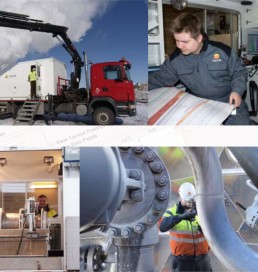Geothermal Well Logging Services
In collaboration with Iceland GeoSurvey, GSE provides a wide range of both open and cased hole logging services. We do this using highly specialized equipment especially suited for the geothermal sector in accordance with the ISO 9001 standard. Iceland GeoSurvey has a long tradition and experience of working in geothermal fields all over the world, and well trained and experienced personnel in logging operations and consultancy as well.

GSE offers geothermal logging services that yield a better understanding of the subsurface conditions in geothermal systems, and provide information for field analysis in regards to:
• Geological subsurface structures of geothermal fields
• Extents and scale of the geothermal reservoirs
• Reservoir monitoring and production forecasting
• Chemical, physical and structural properties of reservoir rocks
• Chemical and physical properties of reservoir fluids
• Chemical and physical processes within geothermal field systems
The logging operations fall within two main temperature categories:
The measured data is transmitted through a 4-conductor standard GO cable head and a 6000 m long logging cable. The Warrior Data Acquisition System, manufactured by Scientific Data Systems, is the primarily used data acquisition tool.
Memory tools with slick-line cables, and cable lengths above 6000 m, are used for high temperature well logging and borehole monitoring. The instruments collect and store primarily temperature and pressure data as a function of time and depth.
Logging Applications
Temperature and differential temperature (400°C)
Used to estimate heat flow, find feed zones and to find out the fluid flow and the formation temperature in the geothermal system.
Pressure logs (400°C)
To estimate flow rate within the bedrock which is governed by the permeability of the rock, the viscosity of the liquid and the distribution of pressure. Production leads to a decline in pressure in the geothermal system.
Caliper logs
To measure the dimension of the well and show cavities where the well is drilled through soft formation, scaling in the well, etc. The tools have either 3 or 4 arms (two pairs). A caliper log is measured continuously from bottom to top and the device sends the data to the surface in real-time.
Resistivity logs 16”, 64” & SP
Measures the electric resistivity of the rock around wells. The resistivity depends on the porosity of the rock along with salinity and the temperature of the liquid in the porous medium.
Neutron logs (n-n)
A neutron source (Am-Be/Ra-Be), placed in the device, sends out high energy neutrons. The n-n logs are useful for the estimation of the porosity.
Natural gamma ray logs
Natural gamma radiation of rock comes from radioactive isotopes, especially K, U’s, and Th. A correlation interposes silica content in Icelandic rock and its natural gamma radiation.
Televiewer
Emits acoustic pulses and detects their reflection from the surroundings, to detect the shape, formation, fractures, casing damage, and other irregularities in the well and its surroundings.
Full-Waveform – Compensated Sonic Probe
To measure formation acoustic-velocity.
Fluid sampling in wells
To find the chemical composition of the fluid.
Fluid Flow
The continuous flow-meter spinner is logged to obtain an overall picture of inflow zones within the borehole.
Cement bound logs (CBL)
To estimate the quality of the cementing of the casings in the well. If casings are badly bounded to the formation it can collapse and cause serious damage to the well. The CBL-device emits an acoustic signal which propagates from the emitter in the probe along the casing to the two receivers higher up in the probe.
Collar Casing Locator (CCL)
Is used to detect variation in the amount of iron in the vicinity of the CCL tool. The recording of the CCL signal is used to locate casing joints and casing damages.
Downhole Video Camera (80°C)
Motion pictures can be taken down to 600 m depth if the temperature is not higher than 80°C. The pictures can be shot either sideways or directly downwards. This equipment is used for studies of fractures, scaling, and casing damage.
Gyroscopic logging
Used in directional drilling to steer the drill bit along the planned track of the well. Real-time information about the inclination, the azimuth (true-north) and gyrotoolface of the well is recorded. The information is used to calculate the exact coordinates of the track. Two types of instruments are used, one type used for kick-off measures individual points, and the other type records continously.
